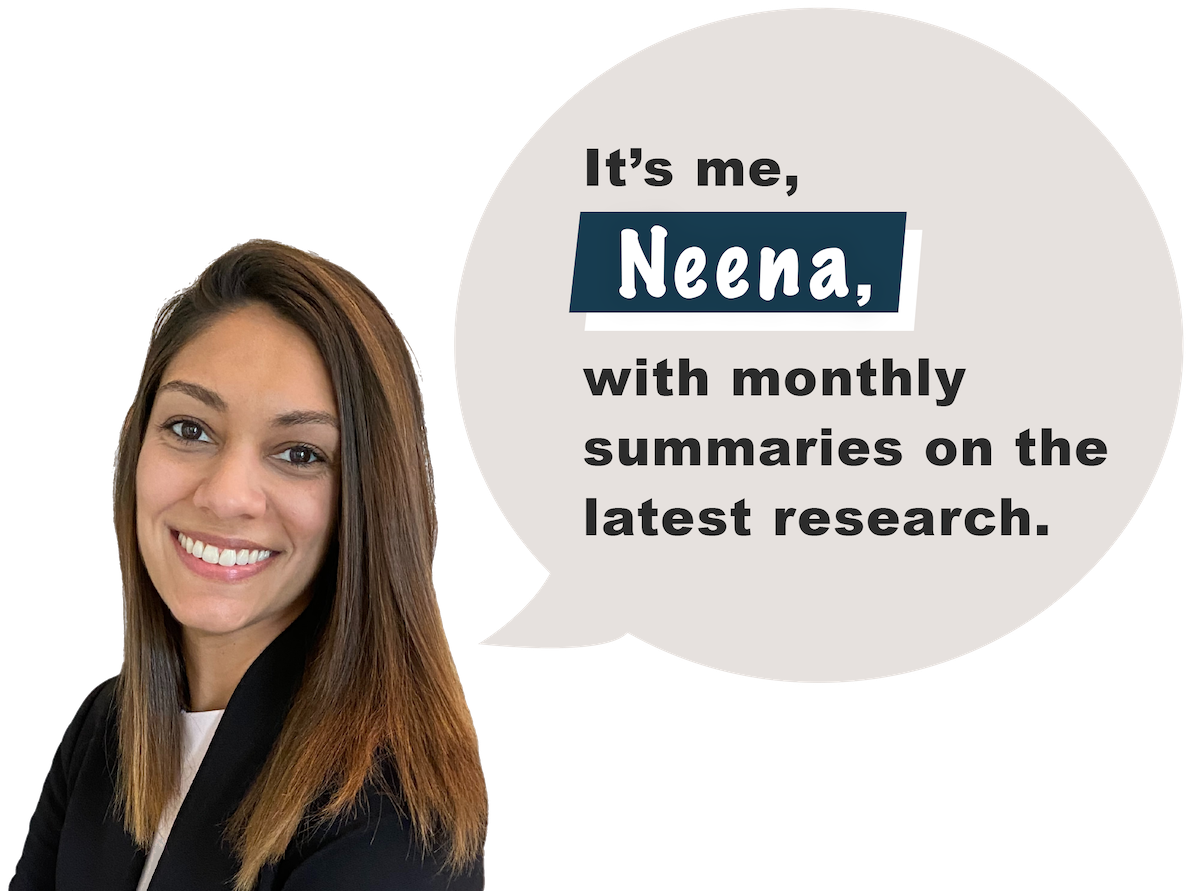 Welcome to the Reading Research Recap!
Welcome to the Reading Research Recap!
I am Dr. Neena Saha, Research Advisor at MetaMetrics and founder and CEO of Elemeno, now a part of MetaMetrics. My focus is to bridge the research-practice gap so that educators can access real-time tools to support reading success. To expand the understanding of research to inform teaching and learning strategies, I put together this monthly compendium of the relevant and must-read research that impacts the reading and learning landscape. I offer research highlights in digestible summary slices. Hopefully, the data and findings you see here are useful to you as researchers, educators, and district and edtech leaders.
Vocabulary Instruction: Meaning, Sound-Structure, or Both?
Does Vocabulary Instruction Also Improve Phonemic Awareness and Nonword Reading?
Hi all! I hope everyone has a great start to the new school year! This month I chose a paper on teaching vocabulary in the early grades because I was intrigued when I read the title of this study: Evaluating the impact of vocabulary instruction on oral vocabulary, phonemic awareness and nonword reading.
We often think of vocabulary instruction as helping build rich semantic or meaning networks, but what if small tweaks to vocabulary instruction could also help promote word reading and phonemic awareness skill? This was the central question posed by this group of researchers.
The TL;DR is yes: there is preliminary (tentative) evidence that whole-class vocabulary instruction that includes teaching the sound structure of words alongside meaning is beneficial in the early grades.
Background
- Vocabulary development is critical for supporting later reading comprehension.
- Yet, early grade teachers often do not provide consistent and explicit vocabulary support (see this paper).
- Perhaps, there is a simple, efficient (whole-class) way to incorporate vocabulary teaching alongside phonics instruction…and that’s exactly what this research group decided to investigate.
Sample
- 273 children in the UK, Ages 5-6 (this is the second year of schooling in the UK)
- They were in 16 classes across 9 schools
- The early schools were randomly assigned to one of the intervention groups (meaning only or sound structure and meaning), while the later schools were assigned to the control condition (please note that full randomization was not achieved here).
Methods
- A quasi-experimental study (since true randomization was not utilized) that took place over 24 weeks (12 2-week units centered on a storybook). The independent variable was the type of vocabulary instruction (the three conditions listed below).
- There were three conditions or groups of vocabulary instruction:
- Combined sound-meaning vocabulary instruction
- “Regular” meaning-only based vocabulary instruction
- Control group or “business-as-usual” group
Instruction
- Both the combined and semantic only groups used the STAR protocol (select, teach, apply, review) and included teaching, games, and review.
- The combined group integrated sound instruction (and morphology) by having the teacher say the following prompts during instruction:
- Let’s say ‘cluster’ clearly. Who would like to act out the word ‘cluster’?
- Let’s clap out the syllables in ‘cluster’ (or tell me a word that rhymes).
- Let’s sound out the phonemes in ‘cluster’ on our fingers.
Measures
- Students were tested on the CELF, the BPVS, the CTOPP, the PhAB2 Nonword reading test, and researcher-created measures of vocabulary learning.
- They were tested at 3 time points:
- September (pre-intervention)
- June (post-intervention)
- November of the next year (to see if the results lasted)
Results
- Vocabulary Outcomes
- At the end of the intervention (time 2) students in both the intervention groups knew more words than the control group.
- At time 3 (delayed post-test in November of the following year), the combined group (the group that received combined meaning and sound structure) knew more words than the semantic-only group* (but both performed better than the control group).
- Phonemic Awareness Outcomes
- There were no (statistically significant) differences between any groups on measures of phonemic awareness…which means that the sound-structure instruction did not seem to boost children’s PA.
- Nonword Reading Outcomes
- At time 3, students in the combined intervention group (the group that received combined meaning and sound structure), outperformed the meaning-only group, but – and this is an important but: time 3 was in the next school year, and students had new teachers by then (the intervention had ended in June), so it could be that their new teachers influenced the scores.
*This was on researcher-created measures, not standardized measures of vocabulary.
Take-home Message
Combining sound structure of words (in addition to meaning) is just as effective as meaning-only vocabulary instruction and might also boost phonics skills (but more research is needed on this last part!).
A quote from the paper:
“The current study provides preliminary evidence that an integrated approach to teaching vocabulary with a dual emphasis on sound structure and meaning enhances vocabulary growth in the mainstream classroom for younger learners.”
Therefore, early grade teachers can consider incorporating sound-structure instruction into their vocabulary instruction!
Ok, that’s all for August!
Teacher & Parent Knowledge, Practices, Beliefs, Curricula
- Squeezed in: Writing Instruction Over Time
- Unhinged: Reading Comprehension Tests as Gatekeepers to Teaching
- The English Lexicon Project – A How to Guide for Researchers and Instructors
- Reliability of Ratings of an English Language Arts Curriculum With the Curriculum Evaluation Guidelines
- A Parent Knows: A Literacy Screener for Parents of Early School Aged Children (Dissertation, not yet peer-reviewed)
- Individuals Who Experienced Early Reading Difficulty: How Teacher Connections and Educational Practices Shape Motivation (Dissertation, not yet peer-reviewed)
- Book Review: Literacy Foundations for English Learners: A Comprehensive Guide to Evidence Based Instruction by Elsa Cardenas-Hagan
Dyslexia, Struggling or At-Risk Readers
- Identifying students with dyslexia: exploration of current assessment methods
- Graphophonological-semantic flexibility and its contribution to reading comprehension in children with dyslexia: A pilot study
- Orthographic influences on phonological processing in children with and without reading difficulties: an eye-tracking study
- Increasing inter-word spacing reduces migration errors and improves reading comprehension in students with dyslexia (open access)
- Evidence-based support provided to struggling readers in later primary years in the UK: A scoping review (open access)
Alphabet Knowledge, Phonemic Awareness, Phonics
- Rapid automatized naming: what it is, what it is not, and why it matters
- The Regularity of High-Frequency Words (Sight Words): Teacher Phonetic Knowledge is Key
- Effect of the development of precursor skills for literacy in Spanish on learning to read in English
- Wordling with Elementary Students: Developing Discrete Literacy Skills through Puzzles and Word Games
- The Role of Cognitive Flexibility in Emergent Literacy
- A Multi-Site Study of Student Experiences with Code- and Meaning-Focused Literacy in Preschool-Third Grade Classrooms
- Examining the Functional Relation Between Variations of a Multicomponent Literacy Intervention and Improvements in Foundational Reading Skills by Young Students With Down Syndrome (Dissertation, not yet peer-reviewed)
Fluency
- Reading skill profiles of dysfluent readers in grades 2 and 3
- Using DIBELS 8th Edition to Assess Oral Reading Fluency and Reading Comprehension of English-Speaking Children in European International English Medium and Bilingual Schools (Dissertation, not yet peer-reviewed)
Vocabulary, Comprehension
- Scrolling and hyperlinks: The effects of two prevalent digital features on children’s digital reading comprehension (open access)
- Cognitive Predictors of Two Distinct Reading Comprehension Tasks in Lower and Upper Grades
- Predictors of multiple-document comprehension among third-grade children with reading difficulties and disabilities (open access)
- A web-based intelligent tutoring system for reading comprehension delivered to fifth-grade students attending high-poverty schools: Results from a replication efficacy study
- Children’s understanding of referential nominal metaphors: a path to the heart of text comprehension
Writing
Other
- The Effects of Educational Technology Interventions on Literacy in Elementary School: A Meta-Analysis
- A Family-Based Intervention for Early Elementary Students With Reading and Behavioral Difficulties: A Pilot Study
- The home literacy environment and children’s emergent literacy development: a follow-up study
- Predicting Response to Neuropsychological Intervention in Developmental Dyslexia: A Retrospective Study

Want to start receiving monthly notifications for this series?
Please register or sign in to your Lexile® & Quantile® Hub account and join our Reading Research mailing list.
 Speaking of the Lexile & Quantile Hub — Exciting news!
Speaking of the Lexile & Quantile Hub — Exciting news!
A completely new version of the Lexile & Quantile Hub will arrive this fall! The redesign features a streamlined user experience and enhanced accessibility to support a range of abilities.

